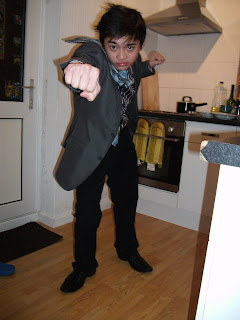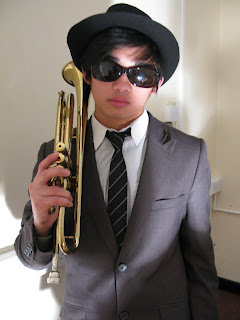Magazine Research:
These two magazines on top are some magazines which I've done research onto. To make my research relevant, I've thought of researching for film magazines to touch down the codes and conventions of real media texts and apply these conventions to my final magazine piece.
The "EMPIRE" magazine seems to include a film strip on the lower part to initially denotate that this magazine has something relevant to do with movies - this makes the audience recognise this signifier and relate it to a film magazine. The magazine's title is the same typeface as what EMPIRE's logo is to reflect the corporate identity and entice the loyal EMPIRE audience to purchase this magazine. This magazine's colour scheme is limited to possibly make the composition match as an artwork to make the viewers like the magazine's presentation. I could take note of this due to the fact that most magazines which I've seen limit their colour scheme. The main protagonist, Bruce Willis, is used in the main photograph - this technique makes the audience recognise an iconic actor, while at the same time, connotating that he is the main protagonist, together along with other actors behind him to apply the two-step flow theory and get anyone who idolises these celebrities to be enticed easier due to the celebrity endorsement.
The Tron magazine, as well as the EMPIRE magazine, has limited their colour scheme. To reinforce this idea, the design has added graphics around the front cover to symbolise the Tron world. Just like the EMPIRE magazine again, they've added the main protagonist on the photograph to make the viewers recognise quickly and using the two-step flow theory, for the audience to idolise these people on the front cover and become enticed. This magazine contains a gimmick, ""WIN! AWESOME PRIZES!" to make the audience feel like they are getting something from purchasing this magazine by having a deal.
Magazine Ideas:
The title of our magazine is 'Memory' which we've agreed upon by connoting it to death and remembering the bloody incidents which happened in the past, therefore "Memory". Memory, as a universal name, can also relate to different genres of movie reviews when used in the future.
In terms of pricing, we came upon our magazine to be £1.50 since our target audience are around the 15 year olds, they may not have that much money to purchase a much more expensive magazine. The magazine should be monthly as not much films are released too frequently.
In the magazine, according to my research of codes and conventions in movie magazines, our magazine title should be on top, preferably middle or top left. Although, with a long name, we've decided upon putting it on the middle to blend with the composition of film magazines. The font should be simple, but with the special horror edition, we could add signifiers of gore, horror, etc. such as blood splatters on the magazine's title, with the agreed colour of red to signify blood.
The main photo should contain a mid shot or a long shot of the three main protagonists with red eyes of the "monster" behind the trio showing the protagonists' facial expressions to inject emotion onto it and signify the genre of the magazine's main headline.
I plan on including a rhetorical question on the front cover such as "Will they all survive?" to entice the readers to look into the magazine and purchase it. Also, an additional celebrity endorsement for the actors can be done with lines such as "find out what they like about...", etc. to engage the viewers about the actors and purchase the magazine. Along the cover, I plan on including gimmicks such as special offers, and other films which will come out to widen the topic pool of the magazine and gain more audience.
The main target for our magazine are over 15 year olds, predominantly male. Our niche audience should be anyone who is interested in horror films, and possibly target people who are interested in rock, emo, metal, etc. music by being related to the featuring film's main genre, and add additional gimmick lines such as "See My Chemical Romance Live!", etc. to entice the audience of special offers, while at the same time, applying the two step flow theory onto it.
The "EMPIRE" magazine seems to include a film strip on the lower part to initially denotate that this magazine has something relevant to do with movies - this makes the audience recognise this signifier and relate it to a film magazine. The magazine's title is the same typeface as what EMPIRE's logo is to reflect the corporate identity and entice the loyal EMPIRE audience to purchase this magazine. This magazine's colour scheme is limited to possibly make the composition match as an artwork to make the viewers like the magazine's presentation. I could take note of this due to the fact that most magazines which I've seen limit their colour scheme. The main protagonist, Bruce Willis, is used in the main photograph - this technique makes the audience recognise an iconic actor, while at the same time, connotating that he is the main protagonist, together along with other actors behind him to apply the two-step flow theory and get anyone who idolises these celebrities to be enticed easier due to the celebrity endorsement.
The Tron magazine, as well as the EMPIRE magazine, has limited their colour scheme. To reinforce this idea, the design has added graphics around the front cover to symbolise the Tron world. Just like the EMPIRE magazine again, they've added the main protagonist on the photograph to make the viewers recognise quickly and using the two-step flow theory, for the audience to idolise these people on the front cover and become enticed. This magazine contains a gimmick, ""WIN! AWESOME PRIZES!" to make the audience feel like they are getting something from purchasing this magazine by having a deal.
Magazine Ideas:
The title of our magazine is 'Memory' which we've agreed upon by connoting it to death and remembering the bloody incidents which happened in the past, therefore "Memory". Memory, as a universal name, can also relate to different genres of movie reviews when used in the future.
In terms of pricing, we came upon our magazine to be £1.50 since our target audience are around the 15 year olds, they may not have that much money to purchase a much more expensive magazine. The magazine should be monthly as not much films are released too frequently.
In the magazine, according to my research of codes and conventions in movie magazines, our magazine title should be on top, preferably middle or top left. Although, with a long name, we've decided upon putting it on the middle to blend with the composition of film magazines. The font should be simple, but with the special horror edition, we could add signifiers of gore, horror, etc. such as blood splatters on the magazine's title, with the agreed colour of red to signify blood.
The main photo should contain a mid shot or a long shot of the three main protagonists with red eyes of the "monster" behind the trio showing the protagonists' facial expressions to inject emotion onto it and signify the genre of the magazine's main headline.
I plan on including a rhetorical question on the front cover such as "Will they all survive?" to entice the readers to look into the magazine and purchase it. Also, an additional celebrity endorsement for the actors can be done with lines such as "find out what they like about...", etc. to engage the viewers about the actors and purchase the magazine. Along the cover, I plan on including gimmicks such as special offers, and other films which will come out to widen the topic pool of the magazine and gain more audience.
The main target for our magazine are over 15 year olds, predominantly male. Our niche audience should be anyone who is interested in horror films, and possibly target people who are interested in rock, emo, metal, etc. music by being related to the featuring film's main genre, and add additional gimmick lines such as "See My Chemical Romance Live!", etc. to entice the audience of special offers, while at the same time, applying the two step flow theory onto it.





































